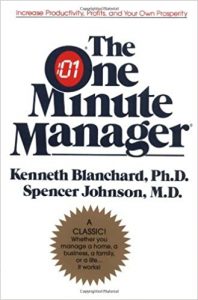A classic business parable, “The One Minute Manager” tells the story of a young businessman’s quest to learn how to lead empowered employees.
I enjoyed the lessons that were taught in this book but found it to be a little corny. The conversations were obviously authored to prove a point but they didn’t feel authentic. If I were the young man in this book I would have asked better questions.
But I do appreciate the conciseness the book provides. The authors could have easily made this a 250-page book and I am glad they did not.
This book teaches the reader how to use psychological triggers to encourage positive action. I enjoyed being reminded of these and it made me reflect on the last few meetings I have been a part of.
I would recommend this book to any manager (Jr. or Sr.) level as it’s a good reminder of how to set goals, communicate, and deliver feedback.
Biggest Insights:
One Minute Goal Setting
- Agree on your goals
- See what good behavior looks like
- Write out each of your goals on a single sheet of paper using less than 250 words
- Read and re-read each goal, which requires only a minute or so each time you do it.
- Take a minute every once in a while to look at your performance
- See whether or not your behavior matches your goals.
The One Minute Praising
- Tell people upfront that you are going to let them know how they are doing
- Praise people immediately
- Tell people what they did right – be specific
- Tell people how good you feel about what they did right, and how it helps the organization and the other people who work there
- Stop for a moment of silence to let them “feel” how good you feel
- Encourage them to do more of the same
- Shake hands or touch people in a way that makes it clear that you support their success in the organization
The One Minute Reprimand
- Tell people beforehand that you are going to let them know how they are doing and in no uncertain terms.
- The first half of the reprimand
- Reprimand people immediately
- Tell people what they did wrong – be specific
- Tell people how you feel about what they did wrong – and in no uncertain terms
- Stop for a few seconds of uncomfortable silence to let them feel how you feel
- The second half of the reprimand
- Shake hands, or touch them in a way that lets them know you are honestly on their side
- Remind them how much you value them
- Reaffirm that you think well of them but not of their performance in this situation
- Realize that when the reprimand is over, it’s over
Summary of The One Minute Manager by Kenneth Blanchard and Spencer Johnson
The One Minute Manager is a simple, yet powerful guide on effective management, focusing on three core practices that can dramatically improve productivity, employee satisfaction, and organizational success. The book presents its lessons through the story of a young man seeking the secrets of great management, who eventually meets a manager renowned for getting excellent results in a short amount of time. This manager shares his three key techniques, known as the “One Minute” management methods.
Key Concepts:
- One Minute Goals:
The first principle emphasizes setting clear and concise goals. The idea is that each employee should know exactly what is expected of them, and these goals should be written in a way that takes no more than a minute to read. After setting the goals, both the manager and the employee can easily refer back to them. Each goal should be:- Specific and measurable
- Clearly defined so that performance can be easily evaluated
- Regularly reviewed, ensuring that employees stay aligned with their objectives
- One Minute Praisings:
The second principle focuses on catching employees doing something right. The One Minute Manager stresses the importance of recognizing and praising good work immediately, reinforcing positive behavior. This can be done in under a minute and should include:- Immediate feedback on what the employee did well
- Specific details about what was done right, so the employee knows exactly what behavior to repeat
- Positive reinforcement to encourage continued good performance
- One Minute Reprimands:
The third principle involves providing immediate, clear, and brief feedback when an employee’s performance doesn’t meet expectations. The One Minute Reprimand is intended to correct behavior quickly and efficiently, without damaging the employee’s confidence or morale. The reprimand should:- Focus on the behavior, not the person, separating the action from the individual’s character
- Be delivered immediately after the mistake is noticed
- Be specific, with a clear explanation of what was done wrong
- Conclude with reassurance, reminding the employee of their value and ability to improve
The Power of Simplicity:
The underlying theme of The One Minute Manager is simplicity. By keeping goals, praisings, and reprimands brief but impactful, managers can save time while fostering better communication and stronger performance. The book advocates that effective management doesn’t have to be time-consuming or complicated, but rather about clear expectations, immediate feedback, and personal engagement.
Employee Empowerment:
Blanchard and Johnson emphasize the importance of empowering employees by giving them autonomy and responsibility for their own performance. By clearly defining expectations and providing regular feedback, employees can take ownership of their work and grow in their roles. This creates a work environment where employees feel valued, motivated, and capable of self-management, leading to higher productivity and job satisfaction.
Conclusion:
The One Minute Manager is a concise, easy-to-read book that distills essential management principles into three actionable techniques: setting clear goals, delivering timely praise, and offering constructive feedback. Through these methods, managers can improve communication, build stronger teams, and create a more efficient and positive work environment. The book’s simple yet profound approach to management has made it a classic, widely embraced by leaders looking to maximize their effectiveness with minimal time investment.
Join The Newsletter
Get occasional emails from me when I publish new projects and articles.



